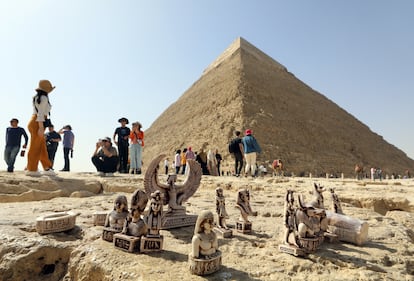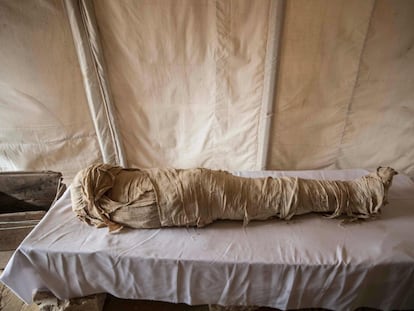Mysterious new corridor discovered in the Great Pyramid of Giza
A team of researchers has been able to trace the exact dimensions of the so-called north-facing corridor, although its purpose remains unknown

The Great Pyramid of Giza, one of the largest stone structures in the world and one of the most emblematic archaeological monuments on the planet, still contains many mysteries 4,500 years after it was constructed on the plateau of the necropolis at Giza, Egypt. Last Thursday, an international team of researchers announced that it had successfully traced the exact position and dimensions of a mysterious nine-meter corridor initially detected in 2016 in the north face of the pyramid and whose purpose remains unknown.
According to the researchers who led the mission and whose study has been published in the scientific journal Nature, the discovery could prove “decisive” in understanding the role of large stone slabs arranged in the shape of a chevron, or an inverted V, which were used for the first time in human history during the construction of the Great Pyramid to cover internal structures and prevent them from collapsing: the mysterious corridor is located just behind this chevron. The researchers state that any breakthrough in archeological knowledge of previously unknown internal structures will lead to a better understand of the pyramid’s construction process.
The main hypothesis that researchers are working with is that the function of the corridor and the stone slabs was to relieve the pressure and weight of a structure located below. The findings were presented during a press conference held by the secretary-general of the Supreme Council of Antiquities of Egypt, Mostafa Waziri, who said that over the coming months efforts will focus on studying the space around the corridor.
The Great Pyramid, which today stands at 139 meters high and 230 meters wide, is believed to be composed of several million pieces of limestone of between one and two meters high. Inside this monumental body, the study explains, lie several large structures connected by narrow corridors: the abandoned subway chamber, the queen’s chamber, the great gallery, and the king’s chamber.
In the Middle Ages a passageway was excavated, which is used today as a tourist entrance, extending from the point in the pyramid where tradition placed the original entrance to an intersection where an ascending and descending corridor connecting these chambers meet. The inverted V-shaped slabs, according to the study, are located at the top of the entrance that connects to the descending corridor, and are believed to have been originally hidden behind the surface of the north face of the pyramid.
An interdisciplinary team of Egyptian and international researchers, called ScanPyramids, has since 2015 been combining non-invasive techniques to better understand the structure of the Great Pyramid and its construction process. One of the techniques used for this is based on the observation of cosmic-ray muons, from which the scientists can create density maps that reveal the internal structures. Shortly after they began their work, the team discovered a void above the pyramid’s descending corridor, which they christened the north-facing corridor. As of 2016, they have been studying it to better understand its shape and location.
The latest research has been able to determine the characteristics of the north-facing corridor, which has a length of about nine meters and a width and height of about two meters. As the study notes, the bottom plane of the corridor is about 20 meters from ground level and beyond it there are no structures measuring more than a meter square, so it remains unknown where it leads.
Despite their findings, the researchers acknowledge that there are still questions. For example, they point out that the data they have obtained is compatible with the corridor not being of a parallelepiped shape, although this represents “the simplest possible form.” They also note that a “southwards continuation” of the corridor with a “smaller transverse section cannot be ruled out,” although the report states that if this is the case, it would have to be smaller than one square meter to remain undetected by their instruments.
Sign up for our weekly newsletter to get more English-language news coverage from EL PAÍS USA Edition










































